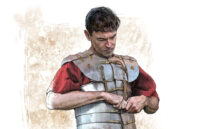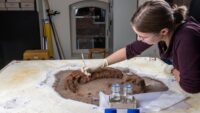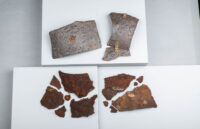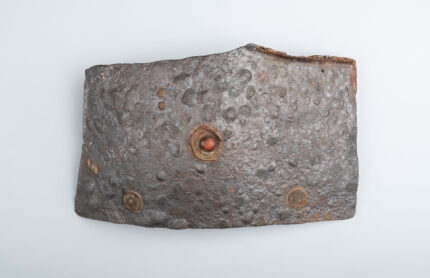 Archaeologists have discovered the oldest and most complete Roman body armour at the site of the Battle of the Teutoburg Forest in Kalkriese, Germany. Before this find, the earliest known examples of Roman lorica segmentata — iron plate sections tied together — were found in Corbridge, UK, and date to the 2nd century. Those were fragments. The Kalkriese armor is a complete set, and includes an extremely rare iron collar used to shackle prisoners.
Archaeologists have discovered the oldest and most complete Roman body armour at the site of the Battle of the Teutoburg Forest in Kalkriese, Germany. Before this find, the earliest known examples of Roman lorica segmentata — iron plate sections tied together — were found in Corbridge, UK, and date to the 2nd century. Those were fragments. The Kalkriese armor is a complete set, and includes an extremely rare iron collar used to shackle prisoners.
More than 7,000 objects have been found at the Kalkriese battlefield site, from weapons to coins to items of everyday use. In the summer of 2018, a metal detector scan of the side wall of an excavation trench retuned 10 strong signals, indications of a large quantity of metal inside the bank. To ensure whatever was in there wasn’t exposed to the air and rapid oxidization, archaeologists removed the entire soil block containing the mystery metallics.
The first step was to scan the block to see what was inside and map out its excavation. The block was too big for regular X-ray machines, so they transported the crate to the Münster Osnabrück International Airport where the customs office has a freight-sized X-ray machine. All they could see was nails of the wooden crate and a large black hole in the shape of the soil block.
In 2019, it was sent to the Fraunhofer Institute in Fürth which has the world’s largest CT scanner — a circular platform more than 11 feet in diameter that rotates while the X-ray apparatus moves up and down — more than big enough for the crate to fit and powerful enough to see inside the dense soil block. The scan revealed the remains of a cuirass — the section of a lorica segmentata where the breastplate and back plate are buckled together. The plates of the armour were pushed together like an accordion by the weight of the soil pressing on down them for 2,000 years.
Here’s a nifty digital animation by the Fraunhofer Institute generated from the CT scan data that reveals the armour inside the soil block.
 Armed with the detailed scans, restorers were able to begin excavation of the soil block. They found that despite Kalkriese’s highly acidic sandy soil, the armour is relatively well-preserved. There is extensive corrosion of the mental, but the set is uniquely complete with hinges, buckles, bronze bosses and even extremely rare surviving pieces of the leather ties. The plates from the shoulder and chest have been recovered and restored. The belly plates are still in the soil block. There are no arm plates in this early design.
Armed with the detailed scans, restorers were able to begin excavation of the soil block. They found that despite Kalkriese’s highly acidic sandy soil, the armour is relatively well-preserved. There is extensive corrosion of the mental, but the set is uniquely complete with hinges, buckles, bronze bosses and even extremely rare surviving pieces of the leather ties. The plates from the shoulder and chest have been recovered and restored. The belly plates are still in the soil block. There are no arm plates in this early design.
 Iron plate armour was introduced by Augustus as an improvement on chain mail. It was relatively light (around 17 pounds) and because the plates were tied together with leather cords, they were much more flexible than chain mail. so it was the latest and greatest technology in 9 A.D. when Publius Quinctilius Varus blundered into a German ambush that obliterated three full Roman legions plus their auxiliaries.
Iron plate armour was introduced by Augustus as an improvement on chain mail. It was relatively light (around 17 pounds) and because the plates were tied together with leather cords, they were much more flexible than chain mail. so it was the latest and greatest technology in 9 A.D. when Publius Quinctilius Varus blundered into a German ambush that obliterated three full Roman legions plus their auxiliaries.
The legionary who wore this armour apparently survived the battle because around his neck/shoulder area was a shrew’s fiddle, also known as a neck violin. This was an iron collar connected to two handcuffs that locked a prisoner’s hands in front of his neck. The Romans used them to shackle prisoners destined for slavery. This time the tables were turned, and the soldier died in shackles.
The restoration is ongoing and is expected to take another two years. Once it’s complete, the armour will go on display in an exhibition at the Kalkriese Museum and Park.

A close friend of a friend works for the Fraunhofer IIS in Fürth (of which the ‘Entwicklungszentrum Röntgentechnik’ EZRT is a subdivision), and it is actually where also the ‘mp3’ audio format had been developed.
If the Kalkriese area is the Varus battlefield site, which it seems to be, there were roughly twenty thousand dead Romans and most of their valuable scrap metal certainly got collected back then.
Six years after the battle, however, a Roman expedition visited the Teutoburg Forest site and (re)buried their dead. According to Tacitus (‘Annals’, I, 61-62):
——————–
“There came upon the Caesar a passionate desire to pay the last tribute to the fallen and their leader, while the whole army present with him were stirred to pity […]. Varus’ first camp, with its broad sweep and measured spaces for officers and eagles, advertised the labours of three legions: then a half-ruined wall and shallow ditch showed that there the now broken remnant had taken cover. In the plain between were bleaching bones, scattered or in little heaps, as the men had fallen, fleeing or standing fast. Hard by lay splintered spears and limbs of horses, while human skulls were nailed prominently on the tree-trunks. In the neighbouring groves stood the savage altars at which they had slaughtered the tribunes and chief centurions. Survivors […] spoke of the tribunal from which Arminius made his harangue, all the gibbets and torture-pits for the prisoners, and the arrogance with which he insulted the standards and eagles. And so, six years after the fatal field, a Roman army, present on the ground, buried the bones of the three legions; and no man knew whether he consigned to earth the remains of a stranger or a kinsman […] At the erection of the funeral-mound the Caesar laid the first sod, paying a dear tribute to the departed, and associating himself with the grief of those around him. […]”
——————–
Abc…123
I looked up “Roman Legion” to get an idea of the size you’re talking about, 4,000 to 6,000 men and 3 Legions lost! That was some battle!
Around 21000 in the roman army at Teutoburg by most estimates. A Roman legion usually had som auxilliaries attached. Non roman troops that would be granted citizenship at the end of their service.
Hang on while I buckle-on my chitonous plastron.
The headline in the Daily Mail (yes,I know) claims that the legionary may have been ‘cooked in a pot’, but gives no source for this suggestion, and I can’t find any reference to it elsewhere. Is it just a made-up shock-horror headline, or was there some deposit perhaps on the armour?
@Mary, my uneducated guess would be that the ‘Daily Mail’ sensed traces of Worcestershire Sauce? :skull:
The Rheinisches Landesmuseum Bonn, or “Bonna”, has the Cenotaph of Marcus Caelius, 1st centurion of Legio XVIII, who fell in the war of Varus. His depiction features indeed a Roman lorica, but seemingly not a ‘segmentata’ one. He even has his own Wikipedia article and his inscription reads:
———————–
M[ARCO] CAELIO TITI F[ILIO] LEM[ONIA TRIBV] BON[ONIA] P[RIMVS] O[RDO] LEG[IONIS] XIIX ANN[ORVM] LIII S[EMISSIS] OCCIDIT BELLO VARIANO OSSA [HVC] INFERRE LICEBIT P[UBLIVS] CAELIVS T[ITI] F[ILIVS] LEM[ONIAN TRIBV] FRATER FECIT
“To Marcus Caelius, son of Titus, of the Lemonian district, from Bonn, first centurion of the eighteenth legion. 53 and a half years old. He fell in the Varian War. Bones may be interred here. Publius Caelius, son of Titus, of the Lemonian district, his brother, erected (this monument)”
———————–
It is not oldest Roman armour found.In reality it is oldest form of this particular kind of armour find and it is not really new since first fragments from it were published already in first half of 90s.In following years many more fragments were discovered and most recently plates overlapping belly which finally allowed to reconstruct with minimal speculation most of this early model.We of course do have fragmentrs of other armour types used by the Romans that are even older and even this model of segmental armour is known from even older fragments than those from Kalkriese.
Possible basis for a hopefully well-made movie, maybe even based on a speculative account of Centurion Caelio’s role and fate in the Clades Variana.
Pretty cool I have a Gladius sword and Shield and Helmet armour next, too go with WW1 WW2 medals head gear bayonets arms rim hats the last of the armour basically. The roman were quite amazing and too think we lost all that knowledge for so long when it’s empire fell. There ruins gave us a idea of there influence when our civilisation falls, actually all empire’s lack humility empathy so civilisation is a bit of a stretch isn’t it . But our legacy will be plastic in the ocean in the animals that live on. No way anything we have made wiliest like the Romans or Greeks or Egyptians . Rome just has fascinated me as did WW1 and my father had me late in life and fought in Africa Java and was on Burma Thai Railway, he taught me about the Romans Greeks etc took me too battle sites I et and Knew Weary Dunlop got pics of my father in A Bomb mess playing Aussie rules. Civilisation amazing and always war technology weapons make it so. I reckon if they brought back the Gladiators again people would watch and love it nothing much change’s except the name’s and the pretence. But amazing find. A movie would be good if they kept too known history instead of the usual licence ship they take of characters .
is there a possibility i can donate to get a fragment from the battle